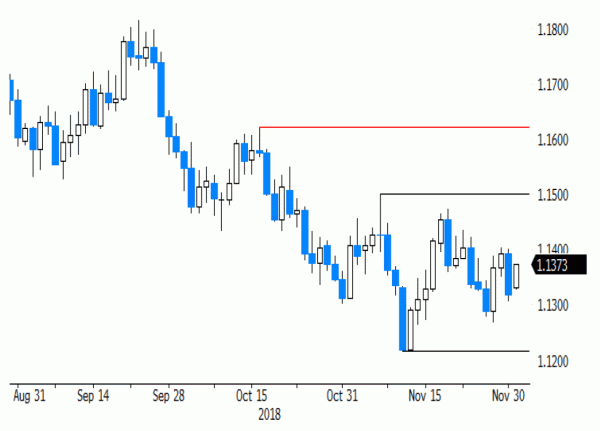- Rates: Risk rebound and higher oil prices weigh on core bonds
Core bonds sell off this morning as US President Trump and Chinese President Xi reached a 90-day trade truce to settle differences. Oil prices surge ahead of Thursday’s OPEC meeting. The risk rebound, higher oil prices and strong expected US eco data (manufacturing ISM) are expected to weigh further on core bonds today. Fed speakers are wildcards. - Currencies: risk-rebound might support EUR/USD, at least temporary
This morning, the dollar returns part of Friday’s gain, as the safe haven bid is easing in the wake constructive China-US trade developments. The positive context should also be EUR/USD supportive. However, it will be interesting to see whether any EUR/USD rebound will have stronger legs than last week’s post-Powell rebound.
The Sunrise Headlines
- US stock markets closed Friday’s session with solid gains (+0.75%). Asian bourses opened firmly in green this morning, as investors welcome the ceasefire between China and the US. Chinese indices outperform.
- US president Trump and Chinese president Xi Jinping agreed to a temporary ceasefire, as Trump suspended his decision to raise the tariff rate on $200bn of Chinese imports starting from 2019. Both parties will now continue negotiations.
- Spanish PM Sanchez’s Socialist party suffered a setback in the regional election in Andalusia, as it only won 33 seats compared to 45 at the 2015 elections. The anti-immigrant and far right Vox party won seats (12) for the first time.
- Oil prices jumped 5% higher over the weekend as Russia and Saudi Arabia agreed to extend their deal into 2019 to manage the oil market (OPEC+) and Canada’s largest oil producing province (Alberta) ordered large output cuts.
- China’s Caixin Manufacturing PMI printed 50.2 in November, the highest reading since August. The index is up from 50.1 last month and beating consensus expectations of 50.1.
- French president Emmanuel Macron held an emergency meeting with his ministers yesterday as the president faces a political crisis due to protests/riots against the high energy prices in Paris and other French cities.
- Today’s economic calendar contains the November US manufacturing ISM and UK manufacturing PMI. Numerous Fed heavyweights speak today, including Fed Vice Chairman Clarida.
Currencies: Risk-Rebound Might Support EUR/USD, At Least Temporary
Risk trade to support EUR/USD, at least temporary
The USD traded with an upward bias on Friday. The post-Powell correction had run its course. Investors were reluctant to take risky assets on board ahead of the Trump-Xi meeting on Saturday, providing a modest safe haven bid for the dollar. A strong Chicago PMI was also USD-supportive. On the euro side of the story, a contraction in the Q3 Italian GDP and a soft EMU core inflation were tentative euro negatives. EUR/USD closed the session at 1.1317 (from 1.1393). A modest USD/JPY intraday gain evaporated later. The pair closed at 113.57 (from 113.48). On Saturday, US president Trump and Chinese president Xi Jinping agreed to halt the race to higher tariffs and to intensify talks to solve the trade dispute. The improved US – China sentiment triggered a risk rally in Asia this morning. At the same time, oil rebounds on growing signs that Saudi-Arabia and Russia might agree on action to stop the recent oil price decline. The trade-weighted dollar is easing below the 97 mark. The likes of the Aussie dollar (AUD/USD 0.7360) outperform. The yuan also profits (USD/CNY below 6.91). The gain in EUR/USD (1.1360 area) is more modest. USD/JPY (113.50) also doesn’t profit from the risk on trade. Today, the final Nov EMU PMI’s and the US manufacturing ISM will be published. Several Fed Members will also give their view going into the December policy meeting. Last but not least, we are keen to see the degree of conviction in the post G20 equity rebound. In theory, a risk rebound in combination with rising oil prices should be USD negative. At the same time, US yields might rise, too. A potential negative risk factor/obstacle for the US economy and for the Fed normalisation process is easing. We start the week with a cautious positive bias for EUR/USD. However, last week’s post-Powell reaction in mind, we are not convinced that the move will have strong legs. For now, we assume the 1.15/1.1621 range top wil remain a tough nut to crack short-term.
In technical trade, EUR/GBP initially hovered in the 0.89 area on Friday. Some sterling shortcovering going into the weekend caused the pair to close at 0.8874. This week, the political noise in the run-up to next week’s Brexit vote will continue to dominate sterling trading. Today, the UK government might come under pressure to publish the legal advice supporting the Brexit bill. One can expect LT investors to stay sidelined as long as the binary Brexit risk persists. We maintain a cautious approach on sterling.
EUR/USD: Risk-on sentiment to open the way for a test higher?













